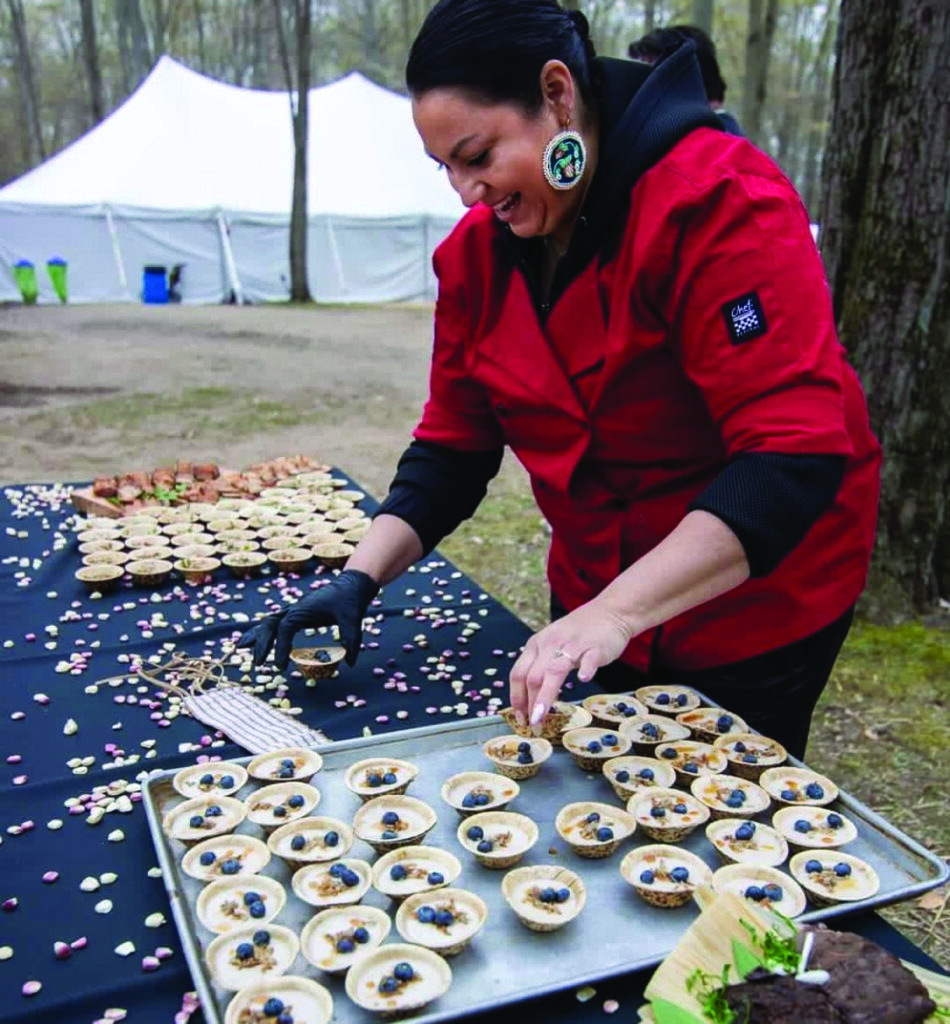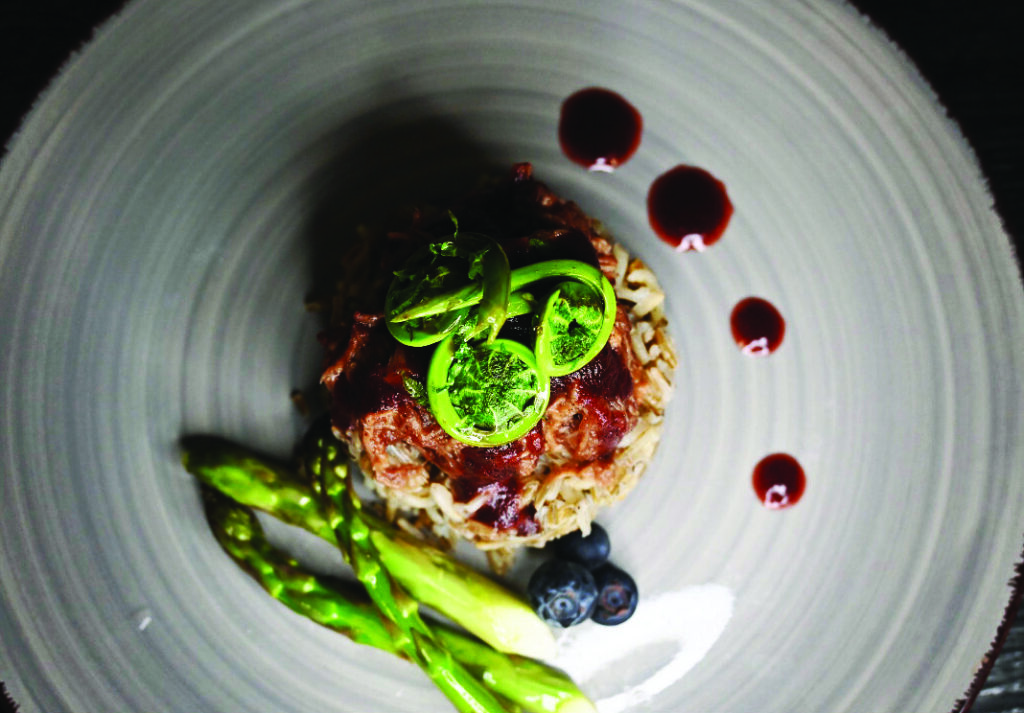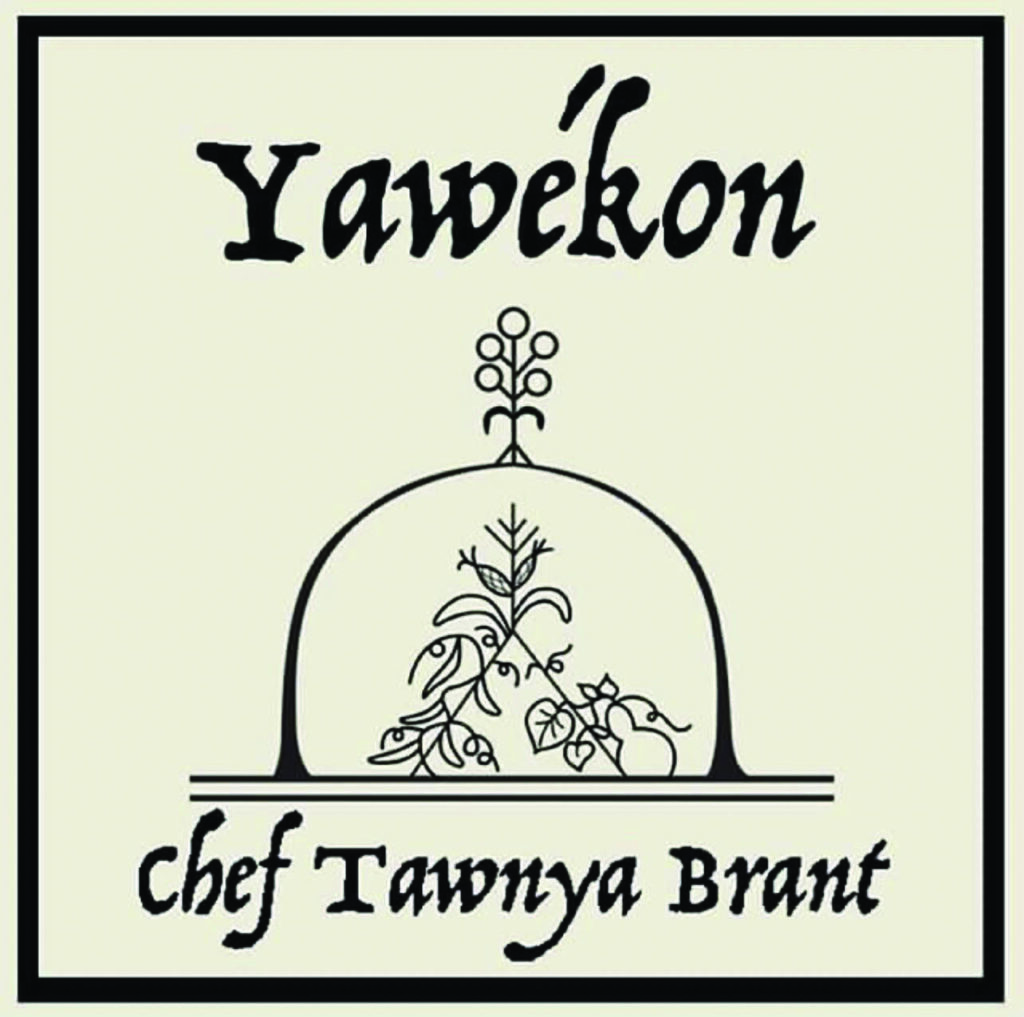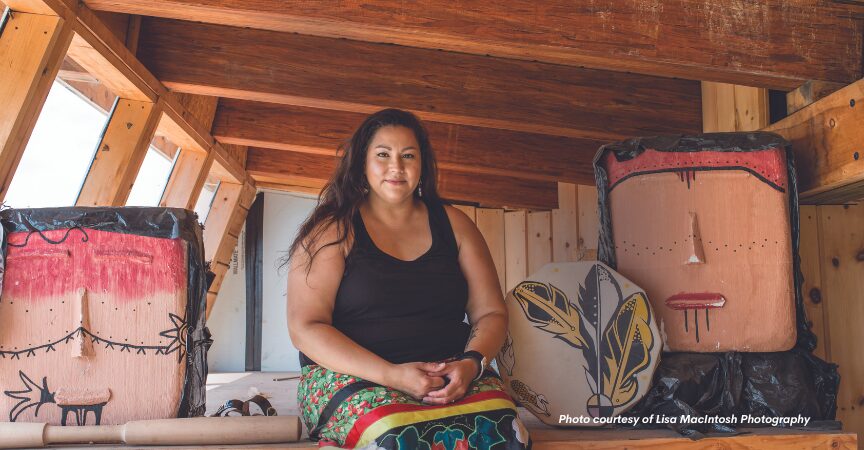Chef Tawnya Brant on Canadian Food & Entrepreneurship

Chef Tawnya Brant is a Canadian culinary rising star, an entrepreneur, a devoted mom and the plainspoken, straight-up cool sister you always wished you had. Even as she balances motherhood, Yawékon, her Haudenosaunee fusion restaurant in Ontario’s Six Nations of the Grand River Territory, and a hectic travel shooting and post-production schedule for her upcoming series on Aboriginal Peoples Television Network (APTN), she finds time to chat about life, love and a few of the most important topics on her radar: restaurants, kids’ nutrition and Canadian food.
Photo courtesy of Elizabeth Hoover
MM: Watching from the sidelines, it would seem your life and career have expanded significantly over the past couple of years. What’s been going on?
We’re putting the finishing touches on the first season of a new series for APTN, tentatively titled One Dish One Spoon, which is scheduled to launch in early 2024. I’m the host, and it’s based around Six Nations featuring local people doing food sovereignty work who don’t necessarily get the recognition they deserve. We called it that specifically because the The Dish with One Spoon Wampum belt, which is the area where we live in southern Ontario. The network was thinking of changing the name for the second season because of how much the series direction has changed, but we’ll see.
In season one, my sister and I set out to answer the question: “Why should I care about Indigenous issues?” There’s a disconnect between everyday Canadians and Indigenous people and we are trying to bridge the gap. I want everyday Canadians to know they were thought of in the making of this type of series, and that we know things are never going to go back to the way they were—we never even said we wanted them to. We have the world we’re in, and we have to live with each other. We’re at a time now where we have to work together. We don’t have a choice because we’re in too desperate a state. More desperate than I think most people realize. This is a big part of why Canadians should care about First Nations and Indigenous issues.
We need to connect and repair our food systems. We need to look at genetically modified foods and realize our environment is not going to sustain their growth. Are we going to live a life where all food is grown inside warehouses? If food doesn’t grow in sunshine, everything about it is fake, which leads to fake people, right? Our foods are breaking down our bodies. Indigenous people LOVE to say, “food is medicine” but right now it’s not. If up to 75 per cent of cancer and disease is related to what we put in our mouth every day, that’s a staggering statistic. Our food is making us sick, so how do we fix that?
I’ve noticed that the “carrot sticks kids” are becoming more the norm. When I work with youth, I see that they’re becoming more aware of what they’re putting in their bodies. Sure, kids love candy, but once they become teenagers and maybe start to play a sport, they’re really starting to think about what they’re eating. I can’t wait to see what they’re like when they get to my age. It’s all connected, from food to mental health in the foodservice industry. Now the general public seems to be having this “aha moment” and they’re realizing the advocates for clean eating are right.
We can’t afford to make mistakes at this point. Food’s too expensive, choosing where we’re going to dine is expensive… I had sticker shock just going to buy food for my kids’ lunches the day before school started. I spent about $160 just on lunch ingredients. If families are spending that kind of money on lunches, that’s a problem and the province needs to look at lunch programs because the nutritional quality just won’t be there.
MM: What are your plans with Yawékon?
I haven’t reopened Yawékon yet, and I’m considering doing a school lunch program. People just can’t afford it and, in terms of affordability, going out to a restaurant is more and more like it was when my mom was a kid—a luxury. Any person in my mom’s generation can tell you the very first time they went to a restaurant, and what they ate. It’s a memory embedded in their mind.
Now, kids don’t want to go anywhere because they’re sick of it. They’ve had the chicken nuggets. It’s all the same damn menu. Many kids just don’t have diversity in their diet. That’s one of the things that really scares me. The province should really look at school lunch programs, and if people have to pay for a lunch program, that’s fine.
Canada is so multicultural, and kids have such different palates. But kids are also adventurous, and if you put them in a room to eat together, they’re more likely to try new things. We need to bring back the community in food and food security. The reality out there right now is shocking. I follow several mom groups on Facebook and an alarming number of moms are saying, “If there’s not enough for the kids, I just won’t eat today.” They’ll eat a cookie or their kid’s leftover lunch. This is what I’m starting to see, and these are everyday, Canadians who don’t have supports for food.
The minute you don’t have food, you introduce corruption into your society. I think we’re looking down the barrel at that, and people either seem to be okay with it or maybe they just don’t know what to do.
MM: When it comes to our food system in general, what do you want to see change?
I want to see everyone fed and fed well. In Canada, this is possible, but we’re not doing it in the right way. We’re doing it in the most expensive way possible, and even as restaurant owners we’re being forced to raise our prices all the time.
If you want your business to be here tomorrow, you have to turn a profit, but how much can customers take? We’re seeing that tension with restaurants closing every day. We’re being priced out of the market, from ingredients to takeout packaging. There’s so much that needs to change from the way we’re doing things now.
They tell us, “Oh, you’re not allowed to use certain takeout containers anymore.” Like it’s no big deal. You just shifted how half of Canadians eat dinner. It’s just not that simple. In Europe or Indonesia, packaging is minimal and recyclable, but we don’t even fully understand the concept or how it’s done. In developing countries, food is served on a piece of paper or you stand there and eat it at a street food booth and return the plate. That’s where this is going, which will mean new challenges for the next generation of restaurants and chefs. I’m not sure they’re thinking that way yet or starting to think about training for that shift.
MM: You’ve travelled extensively and have been exposed to many food systems. What aspects of the Canadian system do you feel are unique and valuable?
We have fresh foods and nearly everything we want available in grocery stores every day. I’m not sure how many people know what a luxury that is. There are a lot of places where that isn’t the case, including some areas in this country. We’ve ridden high for so long, but we’re seeing the repercussions now. Nutrition, delivery and selection are there for us, but we need to work together to preserve and protect that. Nobody wants to change anything—we like things the way they are—they’re fine, right? The question is really whether we’re going to be forced to change it, and do we have time. We’re all stressed out, worried about bills and life and it’s hard to bleed for every cause. But, if everyone took action on one issue or interest that is important to them, we’d be in a much better state right now.
The pandemic was a good preview of what I’m talking about. We had supply shortages and every time you went to the grocery store, food cost more than the week before. Things that were $1.00 went up to $2.00 during the pandemic. Those same items are $4.00 now.
MM: What role do you feel restaurants and culinarians can play in this economy?
You can’t eat at a restaurant every day, but you can connect people with chefs. If you look at TikTok, the obsession with food is obvious, but are you going to make them? Probably not.
I think there’s role chefs can play online to connect with kids and encourage them to appreciate food, try new things and help bring back the simplicity of food. We’ve spent so much time on making food unique, different and new, but we should be asking how we get back to eating what we need. That doesn’t always have to be simple, but it can be simple. Food is for everybody.
MM: How would you define Canadian cuisine?
I don’t know that we have a cuisine so much as we have regional foods. Those regional foods are typically developed from the ethnicity of the people who first arrived in the area.
If you go up north, there are a lot of Hungarians so you’re going to see cabbage rolls and shepherd’s pies and familiar family foods. In Atlantic Canada, there’s a ridiculous amount of poutine and the west coast it’s everything salmon. It’s like adding Europe and the Middle East together and asking, “What is your cuisine?”
We’re finally at a place and time where people are considering Indigenous cuisine within the mix. Over 70 per cent of the food eaten in the world today was originally harvested by Indigenous people from North and South America, which means a lot of the foods we’re eating around the world are Indigenous. Within 60 years of its discovery, corn became one of China’s largest exports. Indigenous people have never really been credited as stewards of these foods since time immemorial, because we were “just savages”, stupid little Indians running around in the trees who didn’t know anything. The reality is, the Haudenosaunee gave the world democracy. We thought about the environment, we thought about each other, we thought about creation, we thought about the future—all of these things were considered. We also had caches with 10 years of food. Most people can’t survive three days. What the hell are we working on so hard?

MM: What aspects of food, and even the approach to food, can restaurateurs and consumers learn from the Indigenous community?
To start, Indigenous people still remember what it’s like to be poor. White people were the first to be colonized, and we’re the most recent over the scheme of about 700 years. I would challenge restaurants to take french fries off their kids’ menu and show me something that’s not a chicken nugget, pizza, spaghetti or macaroni and cheese. That’s about 95 per cent of children’s menus in this country. When you ask kids where they want to eat, they really don’t care because it’s going to be the same damn menu wherever they go. Our kids deserve better than that, and they need better than that. It’s a quick solve for restaurants because they need cheaper food, but we’re so much better than that. You can get stuck in that grind and lose your passion for food—that’s common in the industry. Having my own restaurant, I didn’t want to get stuck in that, and that turned into a seasonal, daily menu, but that’s not reality for many businesses.
Sometimes we are okay with being complacent in the restaurant industry. We start to stick to what we know works because we can’t afford to stick our necks out. Profit margins are
paper-thin, if they’re even there at all. Everybody wants to be paid more, and they need more to live, so we charge more. There are so many things to worry about, we aren’t worried about our $4 menu item. It’s such a rat race in the industry right now.
Being a chef or an operator is a passion, but we’re all suckers for punishment too. There aren’t any clear answers right now, but I feel we’re just not at the “answers part” yet. We’re still in the discussion phase. We’re identifying the problems and thinking about where we’re going. There has to be some way forward. I’d love to see incubators where chefs and owners can share information and ideas. Where we can look for ways to be better and still meet the needs of our customers.
When Yawékon first opened, we served only Indigenous foods, but that wasn’t sustainable. I knew it wasn’t. Almost every customer comes in with some dietary restrictions. It seems like the world is moving toward gluten-or yeast-free diets, but those are our least expensive fillers. We have to get out of the state of being “mindless eaters” and being more deliberate and thoughtful of others.
On Six Nations, we’re taught to live communally. We live in villages of hundreds and thousands of people. You’re thought to think of yourself last. You think of your family, your clan, your nation, your community and only then do you think of yourself. One thing you’ll see with Indigenous business, one of the first things they think about when they open is who they’re going to donate money to. I listen as a business owner and I think the reality is that you’re going to be donating to your business. Young entrepreneurs should look at charity five years down the road.
It’s been a lot of change for me. I’m an entrepreneur and I love business. I love talking about businesses and seeing them grow and improve. For years, my job was to go into restaurants and fix problems. It really sucked when I opened my own restaurant and I couldn’t fix a lot of my own problems. I couldn’t find enough people in my community who were passionate about our food. It’s important to me that this food knowledge goes back into my community first, because it needs to. Working with “endangered foods” isn’t easy because you don’t know what you’re going to have day to day. Seasonal is beautiful and I still think it’s worth serving and that it’s worth that struggle and fight to have it. Knowing now how many people relied on our food made it a really hard decision to close down for the summer. I had to think about it, talk to everyone and their grandmother about it and cry about it, but it was knowing how many elderly people are served by our shop and the only other option they had in our community because they’re gluten-free is french fries.
That was the only other option they had in our community. I felt like sh*t, but the reality is I have a career outside of that shop. I thought, at two and a half years in it could run on its own, but that’s not what happened. It’s really hard in a community where you can sit in another shop an get paid $20 an hour; where you can work on your bead work or do whatever you want. It’s a real challenge to find people who want to work that hard. Many of us in this industry are suckers for punishment.
I make my money catering and that’s what’s been keeping the ship afloat. I don’t like doing things that don’t make money, right? I volunteer enough of my time, so if it’s not working, it’s not working. Breaking even doesn’t work for me. If everything I’m doing is supported by just one thing, then that’s where I need to focus my time and effort.
I want my community to have a daily option, but does that mean I go to other restaurants and ask if they’d do a different menu? We’re in the realm of “I don’t know,” and the answers are going to be different for everybody. I think chefs and business owners have been feeling that way for a few years now and they’re just happy if their doors are still open, and if they’re turning a profit, even better. Just look at the lengths people are going to to “be different.” Like square croissants… I admit it, I want to see a square croissant, but is that something I’m going to have every day? Probably not.
MM: When you opened, did you set out to make Yawékon different? What lessons have you learned along the way?
The difference between my restaurant and every other Indigenous restaurant you see is that mine’s the only one on Territory. I’m feeding the community and the people; the ladies who want salads at the Band Office every day. I’m not feeding people who are looking for some kind of Fear Factor experience. I’m balancing the familiar routines of everyday lunch with people who want traditional foods for their health and the tourists who want to try Indigenous foods. Other Indigenous restaurants are located in big cities, inside museums or other tourism-based places. That’s what makes Yawékon different. We’re a small, shoebox of a shop with no stability in the foods I have access to. With all the challenges in this industry, my business shouldn’t exist, but it does. It’s because I’m willing to take on that personal challenge, but I’ve learned a lot.
And “location, location, location” is definitely a thing. It’s part of Yawékon’s success. We’re located in a main plaza in the middle of Ohsweken in the midst of about 900 people working Band Council jobs. Being centralized in a local area like that is huge, and my business style wouldn’t work anywhere else without my specific skillset.
I want to reopen, but not necessarily in the same capacity as before. I know now that if I have to work with unskilled workers, I have to make stations and train on those stations to manage turnover. That’s heartbreaking for me, because I wanted to mentor people and other Indigenous chefs. When I started to talk about opening Yawékon, I got all these emails from people wanting to train, and I was worried because I can only have three in the kitchen or we’d be banging into each other. I didn’t get a single message back from those people when I actually did open. They lived in communities across Canada and would have had to move hours and hours away, mostly for the love of it, as we couldn’t pay a lot.
At the end of the day, if I can find a way to remain a sole proprietor, I’m going to do that.
MM: What do you think lies ahead on your journey?
I’ve been in writer’s meetings all week for the second season on APTN, which has landed in the “docusoap” category—kind of like a reality series—because it focuses more on me and my sister, family and friends. It’s focused on my entrepreneurship journey and we’re shooting that now.
I’ve had hospitals ask me about doing Indigenous cuisine for patients and I would really like to do that. To me, one hospital can open the floodgates to every hospital in the country. If they’re offering halal and kosher, why aren’t they offering Indigenous foods? It’s on their minds, and if they’re approaching me, I want to see if we can do that. I’m looking at larger facilities and impacts. There’s no reason we can’t figure out how to serve hospitals and schools. Even if they’re pre-packaged meals they just need to stick in a convection oven and serve, I think it’s worth looking into.
The truth is, I was never that interested in high-end food, so the fact I did Top Chef Canada is kind of amazing. They asked me for about two years and I kept saying no because I didn’t want to leave my kids for the month of shooting. The next time the opportunity came around, my shop had been open for six or seven months and it was more like, “Please take me—I’m ready to go away for a little while.”
MM: How does your family feel about participating in the second season of the APTN show?
I think I’ve eased them into it enough so that they’re like, “Okay—just let me know if I need to do anything.” My dad just wants to know if he needs to clean the yard. As long as everybody knows what’s going on they’re generally pretty cool with it. My fiancee’s super supportive, and without him I wouldn’t be able to do what I do and raise our boys. He’s the reason I’m able to have a career and have a family.
When the shop’s open it works out perfectly, but right now it’s a little chaotic. We’ve been travelling a lot and just got back from upstate New York. We did a trip to the Mohawk Valley to see my paternal and maternal ancestral villages. It was great to be able to take the boys.
There’s a Chef Expo in Minneapolis, Minnesota for the Native American Health Conference for about 700 people. They have 14 Indigenous chefs from all over—Hawaii, New Zealand—it’s a big scope. I’m excited to go and see some friends.
MM: What do you think the future holds for the restaurant industry? What insights can you share with other chefs and foodservice entrepreneurs?
The reality is creeping up on us that sh*t’s going to change whether we like it or not. By the time my kids are my age, food’s not going to look like it does now. Already, kids’ lunches don’t look like they did when I was a child.
People look at me and say, “Oh, I want to be an Indigenous chef.” They have no idea the hell I’ve been through to do what I do. Most people don’t have a mom who’s a Seed Keeper, who’s going to raise them on ancestral foods—who are going to put the work in. It took me 20 years to find the self-confidence to say that I’m a chef out loud. That comes from getting respect from the industry. I questioned myself, yet others graduate from culinary school and have no problem owning that title. Well, if they are, for f**k sakes I am too. You can call me “Chef Tawnya”.
Those things are there and they’re real. I don’t like to sugar coat it. You might get a couple of newspaper or online articles, but what are you really doing? There’s a reason you work in a bunch of restaurants before you open your own. You want to see every problem from every angle and learn how you can fix it or even identify it before it happens… or before you’re bankrupt. There’s a lot to keep track of and it can take you down from behind. You need to be a bit of a sucker for punishment, like to work really hard in 100-degree weather, sweating, lifting 50-pound boxes, knowing that you’re not going to be able to do this in old age—these are the realities of the industry. If you don’t know anything and aren’t contributing to the future of the industry, you have a rough road ahead of you.
But at the same time, it’s so much fun. And if you love it, you f**king love it.

IG: @cheftawnyabrant
FB: @cheftawnyabrant









